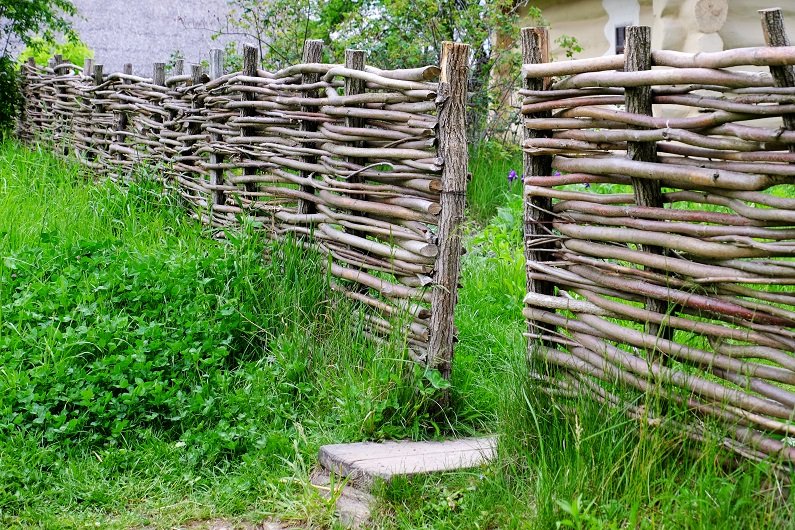Is a wattle fence appropriate for the home garden?
Yes, they are excellent for screening of the small garden utility area to give privacy. They are made of thin split saplings and are quite durable.
I have a horizontal clapboard fence but it looks rather monotonous in design. What can I do to make it more interesting?
Since it is of wood, clinging vines would not prove satisfactory. Why not espalier a pyracantha, yew, or fruit tree against it?
Where can I get a design for a picket fence?
There are many designs for the old-fashioned picket fence. To select the right one, consult a general garden book.
What sort of fence is best for use along the road in front of a modified colonial house where something elaborate would be out-of-place?
A simple post-and-rail fence, such as the one in the accompanying sketch, has proved very satisfactory. It can be painted white, or if made of chestnut, cypress, or redwood, left unpainted to weather. If it has to be made proof against small animals, wire can be attached to the inside.
I need a moderate-priced fence to shut out the view of the street from my front lawn. What shall I use?
A fence of palings made of 1 x 4 in. redwood, 5 ft. 6 in. high, will answer your purpose. Or a stockade-type fence which comes already built in sections of varying heights.
How should I construct a retaining wall, to be built of stones?
Since it may be called upon to withstand considerable pressure, a dry wall must have an adequate foundation, and the stones must be firmly bedded. The accompanying sketch shows that the foundation is as wide or wider than the wall and goes down below frost level. The face of the wall slopes back slightly, and all the stones are set with the long dimension horizontal. Use squarish rather than rounded stones, and use as large ones as you can get. Avoid “chinking” with small stones.
How do you make soil pockets in which to grow plants in a dry wall?
As the wall is being laid, leave gaps all the way through it, about 4 ins. in diameter. Be sure these opening slope downward toward the back of the wall to keep soil and plants from being washed out. See that the soil is continuous from the face of the wall to the soil back of the wall to permit moisture to penetrate to it constantly. Fill the holes thus made with rich soil. Be sure the stones above them make solid bridges over the holes.
What kind of gate is best to use with a clipped privet hedge?
A well-designed gate of stained, weathered, or painted wood, or wrought iron.
Do you recommend wire gates for gardens?
Wire gates are not usually so decorative as wooden or iron gates. They are suitable for vegetable areas or dog runs.
To be correct, must the planting either side of a garden gate or entrance be the same?
A symmetrically balanced arrangement is the usual thing, but it is often less interesting than an unsymmetrical treatment such as the one in the following sketch. Here a ceramic container planted with a shrub is balanced by the tall, dark evergreen on the other side. Such a treatment is easier to arrange when the position of the entrance, or conditions of shade, etc., make a symmetrical arrangement difficult. It is more lively and striking.
We have a picket fence but have difficulty with visitors not thinking to close the gate. How do you construct one of those self-closing affairs?
The old method used in colonial times was simple enough. Merely place a heavy metal ball on a chain. Attach one end of the chain to a sturdy post about 4 ft. high, the other end to the gate. In this way the weight of the ball closes the open gate.

